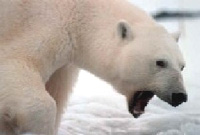
| Polar Bears' Climate Change Risk Growing | 22 September 06 |
 The retreat of sea ice in the Arctic is forcing the world's wild polar bear population into an unnatural fast which speeds up threats associated with climate change. The retreat of sea ice in the Arctic is forcing the world's wild polar bear population into an unnatural fast which speeds up threats associated with climate change.Scientists are now saying that earlier annual break-up of sea ice is cutting short the spring hunting season for bears. Polar bears are completely dependent on sea ice for their essential needs, including hunting their prey of seals. Female bears rely on spring hunting season to build fat reserves needed to see them through summer months. The retreating ice means they have not had time to build up normal levels of fat - which can reach a thickness of 12cm. As females become thinner, they are more susceptible to disease. Their ability to reproduce and the survival chances of their cubs decline significantly. The loss of sea ice has caused the polar bear population in Western Hudson Bay to decline from approximately 1,200 bears in 1987, to 1,100 bears in 1997, and then to fewer than 950 bears in 2004. The US court case against the federal government initiated December 2005 by the Center for Biological Diversity, NRDC, and Greenpeace was settled on June 29th, 2006. The US Fish and Wildlife Service has until December 27, 2006 to complete its "12-month" finding as to whether polar bears will be listed under the Endangered Species Act. View the September 15, 2006 Independent Online (UK) article View the Center for Biological Diversity web page on the Polar Bear View the February 6, 2006 Manitoba Wildlands news item Sources: Independent Online (UK), Center for Biological Diversity |
|
